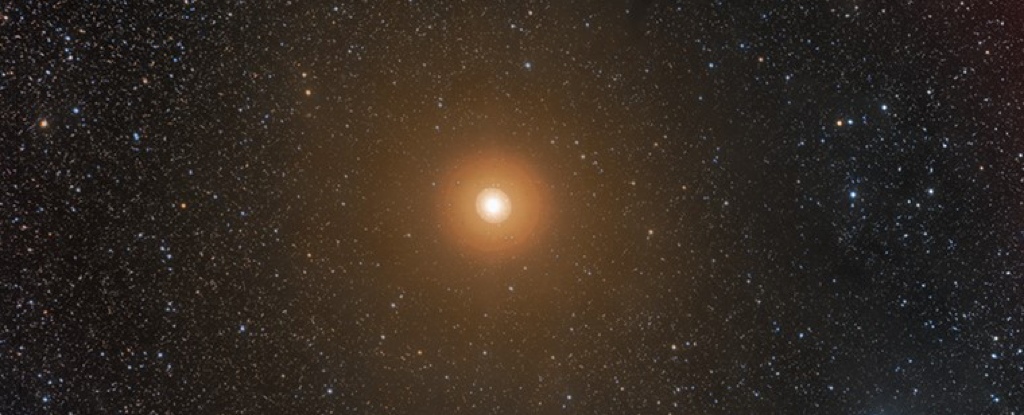Products You May Like
Today, it’s on the brink of death: a huge, red ball of flame, glaring like a baleful, bloodshot eye before it winks out into a tiny pinprick of degenerate matter.
But red supergiant Betelgeuse was not always this way. Once upon a time, the star was a main-sequence monster – a blue-white O-type star, the most massive stellar weight class, fusing hydrogen like it was going out of style. As it reached the end of this live-fast-die-young lifestyle, it would have turned a more golden hue. And now astronomers have figured out how recently this was.
According to a review of observations of the star dating back to antiquity, it would have been yellow-orange in hue around 2,000 years ago. The transition to its current ruddy shade happened in the cosmic blink of an eye, even for a star with as short a lifespan as Betelgeuse.
But measuring the duration of this transition isn’t just to satisfy idle curiosity. It has allowed an international team of scientists led by astronomer Ralph Neuhäuser of Friedrich Schiller University Jena in Germany to make a new estimate of the star’s age – which, in turn, has given us a new timeline for its inevitable supernova.
Betelgeuse, just 700 or so light-years away, is one of the biggest, and brightest, stars in our sky – a giant star at the end of its life.
It’s almost burnt through its reserves of hydrogen, the fusion of which in the core of a star powers that star throughout its life. Instead, it’s now working its way through its helium, the fusion of which into carbon and oxygen has caused the star to expand outwards to gargantuan size.
Once it has run out of material to fuse, the star will go supernova; its core will probably collapse into a neutron star.
And in recent years, after a series of dimming events, the star has been the subject of tabloid scaremongering, stating that Betelgeuse could blow any day now, and by gosh we are all going with it. (Spoiler: it won’t, and we are not.)
However, while we know that Betelgeuse’s demise isn’t imminent – at least on human timescales – we don’t know exactly when it’s going to happen. Or even how long since it puffed up into a red supergiant. The current best estimate is around 40,000 years ago.
But we don’t have to rely on just our observations of the star now. Humans have been recording the sky for millennia… and those ancient texts, Neuhäuser and his colleagues surmised, could contain the answer.
They scoured historical records looking for references to the star. And they found them. Two millennia ago, ancient astronomers were referring to Betelgeuse as yellow.
In 100 BCE, in his Treatise on the celestial offices, Han Dynasty court astrologer Sima Qian described the star as being yellow in hue. Sirius, by contrast, was described as white, Bellatrix as blue, and red supergiant star Antares was described as… well, red.
If Betelgeuse was the same color, surely it would not be described as yellow.
“From these specifications,” Neuhäuser says, “one can conclude that Betelgeuse at that time was in color between the blue-white Sirius and Bellatrix and the red Antares.”
Then, around 100 years later, along came Roman scholar Hyginius, author of a work titled De Astronomia.
“Solis stella… corpore est magno, coloure autem igneo, similis eius stellae quae est in humero dextro Orionis;… Hanc stellam nonnulli Saturni esse dixerunt…” Hyginius wrote. “The Sun’s star… body is large (i.e. bright), and color/coloration fiery/burning; similar to that star which is in the right shoulder of Orion (i.e. Betelgeuse)… Many have said that this star is (the star) of Saturn…”
This is an even more solid example – the color of Betelgeuse compared to the color of the Sun, and of Saturn, which appears more tawny than red. Other stars described by these observers are given accurate hues, the researchers say, paying special attention to descriptions of Antares, red giant Aldebaran, and red giant Arcturus, all described as red.
The changing color of Betelgeuse can be traced. By the 16th century, according to observations by Danish astronomer Tycho Brahe, Betelgeuse was redder than Aldebaran. Today, it is redder still, closer in hue to Antares – a star whose name means ‘like Mars‘.
This transition, and the time it took, gave the researchers a parameter with which to estimate Betelgeuse’s current age, and how long it has left before it goes kaboom.
“The very fact that it changed in color within two millennia from yellow-orange to red tells us, together with theoretical calculations, that it has 14 times the mass of our sun – and the mass is the main parameter defining the evolution of stars,” Neuhäuser explains.
“Betelgeuse is now 14 million years old and in its late evolutionary phases. In about 1.5 million years, it will finally explode as a supernova.”
So we’ll be enjoying our fascinating red friend for some time to come.
The research has been published in the Monthly Notices of the Royal Astronomical Society.
